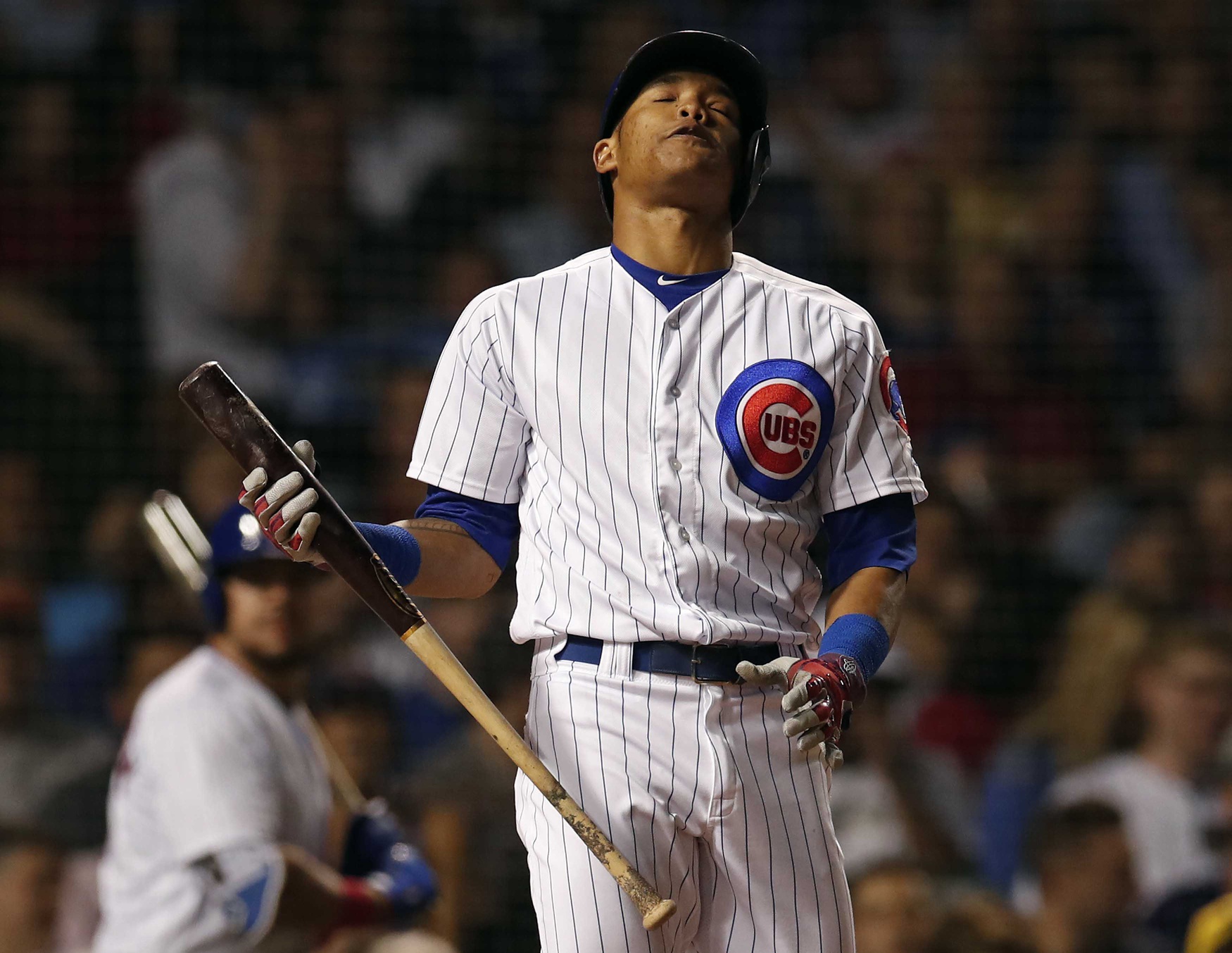The struggles of some players can be characterized as relatively black and white. Addison Russell’s come with a ton of gray. With an offense that has been somewhat hot and cold early in the season, no player has brought about the consistent frustration that Russell has, at the plate, on the basepaths, or occasionally in the field. In short, it’s been a troublesome on-the-field start for a player that many soured on going back to last season.
That’s not to say that it’s all been bad for the young shortstop. On the surface, there are some things to like about his overall production, even if the game-to-game stuff has been a bit more frustrating. After a season in which he posted a 1.7 WARP, Russell is on pace to easily eclipse that, with a 0.8 mark. His batting average is up nearly 20 points from 2017, with a .256 mark through Sunday, along with a super respectable .343 on-base percentage, up from .304 last year. His TAv is up slightly, going from .255 last year to .260 in 2018, while FanGraphs has his wRC+ at 96, just a touch below league average.
There’s also the matter of his approach, which has been really strong to start the year. He’s striking out at a rate of 17.9 percent, down about six percent from last season. His walk rate is at 11.2 percent, a jump of about four percent, the fifth best at the position across both leagues. ESPN has his pitches per plate appearance ballooning from 3.86 to 4.13, the 24th best mark among position players in the National League.
But in addition to his improved approach, which has resulted in an increased ability to reach base consistently, there are some concerning factors moving forward.
For one, any sort of power from Russell has been just about non-existent. His ISO is currently sitting at just .111, down from .179 last season. This comes despite a groundball rate that has fallen about five percent (35.9%), with subsequent increases in LD% (26.1) and FB% (38.0). Given his penchant for soft contact, though, it probably isn’t a surprise. Russell is making soft contact at a rate just over 23 percent, a startling increase of 10 percent from last year. That’s the 14th-highest mark among National League position players. It’s really difficult to determine exactly what’s causing such a sharp decrease in the quality of his contact, too.
Russell is swinging at fewer pitches than ever, so his Swing% against various pitch types is obviously down across the board. Fastballs have seen the sharpest decrease, with his 42.7 percent swing rate against the hard stuff coming in at about an eight percent decrease. He’s actually seeing more fastballs from opposing pitchers, too. He’s still hacking at offspeed pitches at about 57 percent of the time, which could be somewhat hard to generate consistent hard contact against. Joe Maddon has attributed it to some struggles on the center and inside parts of the plate, which would allow him to drive the ball to left field. There’s an obvious validity to that, as Russell is only pulling the ball 26.6 percent of the time, down 15 percent from last year. Fifteen. Percent. That really does speak to what Maddon is saying there. An increased focus on the inner part of the plate could be in the cards for Russell, which could spark something on the hard contact and power side.
Some of the issues with Russell are being showcased on a game-by-game basis, including Sunday’s finale against the Chicago White Sox. With Lucas Giolito struggling to find the zone in the first inning, Russell hacked at the first pitch before going down on three pitches. He then committed a pair of baserunning errors in the same inning, failing to score on a deep Ian Happ double before being tagged out between third and home on a chopper to the third baseman that should have been an easy sign to retreat. He had a couple of throwing miscues in the field in the previous weekend’s series against St. Louis. Could these things be a matter of Russell not being as mentally engaged as he should be? It’s a troubling possibility.
It’s a really difficult thing to figure out. Even more frustrating is the fact that he hasn’t been bad. But he hasn’t exactly been good, either. While his fielding issues have been relatively isolated, his quality of baserunning and any semblance of power are certainly on a downslide. One would imagine, though, that whispers (and in some cases screams) of Manny Machado being a potential trade target, it would spark something in Russell to work on the things that would make him the asset that so many have believed he could be in this Cubs core. Maybe focusing on some zone-related tacts at the plate could be the formula he needs in order to improve moving forward. It’s also somewhat tough to criticize the approach that has shown quite a bit of growth this year.
This all leaves Addison Russell as somewhat enigmatic, both in diagnosing the issues and actually managing to fix them. Regardless, this will be an intriguing thing to watch moving forward, given his role with the Cubs for the foreseeable future and the availability of alternatives on the trade market.
Lead photo courtesy Jim Young—USA Today Sports
